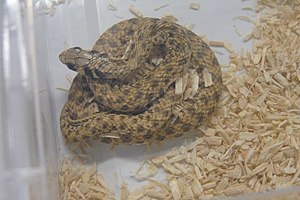Moilan snake
| Moilan snake | ||||||||||||
|---|---|---|---|---|---|---|---|---|---|---|---|---|

Moila snake ( Rhagerhis moilensis ) |
||||||||||||
| Systematics | ||||||||||||
|
||||||||||||
| Scientific name of the genus | ||||||||||||
| Rhagerhis | ||||||||||||
| Peters , 1862 | ||||||||||||
| Scientific name of the species | ||||||||||||
| Rhagerhis moilensis | ||||||||||||
| ( Reuss , 1834) |
The Moilanatter ( Rhagerhis moilensis , Syn .: Malpolon moilensis ) is a species from the superfamily of the adder-like and viper-like (Colubroidae). The distribution area extends in North Africa from Mauritania to Egypt and south to Sudan and over the Arabian Peninsula to Iraq and Iran . It has furrow teeth in the back of the jaw that are connected to poison glands and is therefore assigned to the non- monophyletic group of snakes .
features
The Moilanatter is a medium-sized snake and reaches an average length of about 70 to 95 cm, with maximum lengths of up to over 100 cm being documented. It is a slender, long-looking snake. The body color is reddish yellow to sand gray. The drawing on the back consists of indistinct dark spots that merge into smaller spots on the flanks. Behind the corners of the mouth there is a bar mark that pulls towards the throat, and there is also a dark mark below the eye. The ventral side is creamy white and may have reddish speckles.
The head is triangular and indistinctly set off from the body. The large eyes have a round pupil . The snout shield is elongated and pushes its tip between the two intermediate nose shields . In addition, the snake has a rein shield , a forehead shield, two or three rear eye shields and seven to eight upper lip shields , of which the 3rd and 4th or the 5th and 6th touch the lower edge of the eye. The edges of the over-eye shields are less pronounced than those of the closely related European lizard snake. There are 17 rows of scales around the middle of the body.
distribution and habitat
The distribution area extends in North Africa from Mauritania to Egypt and south to Sudan and over the Arabian Peninsula to Iraq and Iran .
As a habitat, the animals colonize desert areas with sparse vegetation, especially stone deserts up to heights of a maximum of 1,500 meters. They are also occasionally found near human habitation.
Way of life
The moila snake is diurnal and moves forward very quickly. In the winter months it hibernates for several months . Their range of prey mainly includes lizards , snakes and small mammals and, more rarely, birds. The young animals also feed on large insects.
The mating season for the snake is April to June. The females lay eggs, the clutches consist of fewer than 4 to 18 eggs, which are laid in piles of leaves, damp earth or masonry. The young snakes hatch from late September to early October.
Snake venom
Moilan snakes have a poison that is effective for their prey, which they can bring into a wound via the rear furrow teeth (opistoglyph). The snakes can also bite people if caught. The poison is painful for humans, but relatively harmless and is usually not used due to the poisonous teeth that are far back.
literature
- Ulrich Gruber: The snakes of Europe. Franckh'sche Verlagsbuchhandlung, Stuttgart 1989; Pages 151–153. ISBN 3-440-05753-4 .